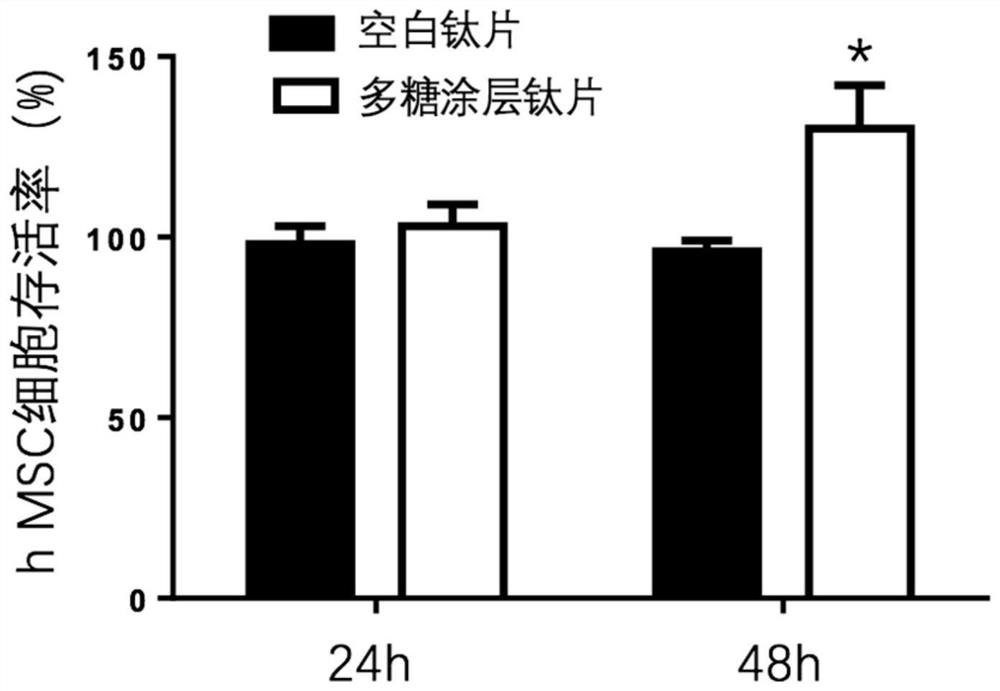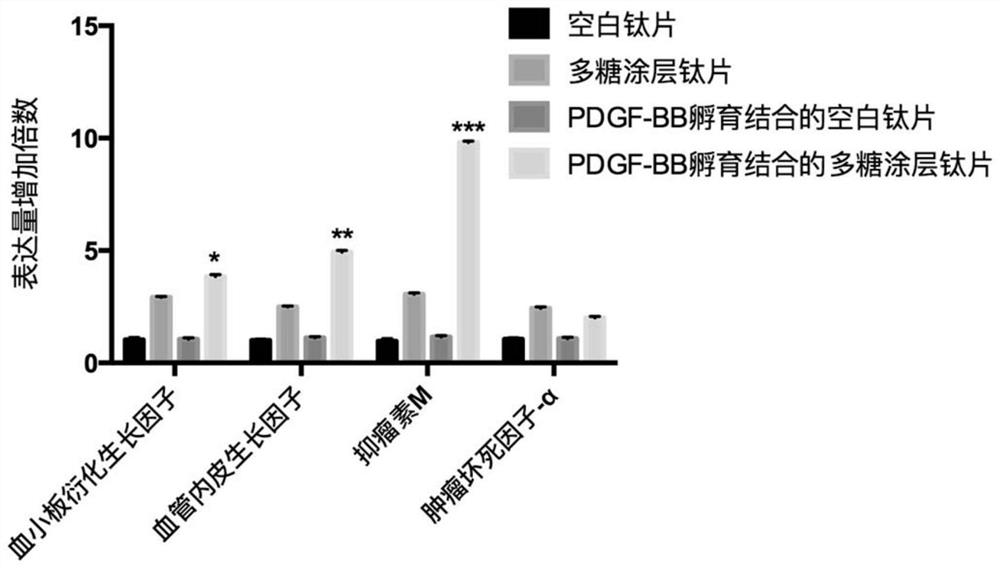Implant containing polysaccharide coating capable of binding growth factors and preparation method thereof
A growth factor, polysaccharide coating technology, applied in dental implants, medical science, dental prosthetics, etc., can solve the problems of low cost performance, long cycle, complicated preparation process, etc.
- Summary
- Abstract
- Description
- Claims
- Application Information
AI Technical Summary
Problems solved by technology
Method used
Image
Examples
preparation Embodiment 1
[0046] Anchor amino groups by plasma treatment: Use plasma-enhanced chemical vapor deposition equipment to anchor a layer of nano-thick amino groups on the surface of titanium sheets.
[0047] First, the vacuum chamber was pumped to 10Pa, argon gas was introduced, and the titanium sheet (substrate) was cleaned with Ar gas plasma for 10 minutes under the condition of power of 100W; The air pressure in the vacuum chamber reaches 21KPa; use acrylamine (ALA) with a purity of 99wt% as component steam to form an amine polymer deposition layer on the surface of the titanium metal substrate, turn on the power, adjust the discharge power to 150W, the frequency to 200kHz, and the initial steam pressure to 0.200mbar . Treat for 30 seconds to form a pinhole-free amino polymer film with a thickness of about 30nm on the surface, turn off the power to stop the discharge, continue to pass the monomer for 5 minutes, and then take out the sample for use.
preparation Embodiment 2
[0049] Dopamine copolymer film immobilizes amino groups: Utilizes the strong adhesion of dopamine to the surface of most materials to form a dopamine-polyethyleneimine (PEI) copolymer film rich in amino groups on the surface.
[0050] The ultrasonically cleaned titanium substrate was immersed in an alkaline dopamine solution (0.12 mg / ml 10 mM Tris solution, pH 8.5) for 30 minutes to allow dopamine to spontaneously oxidize and copolymerize. Then, a mixture of dopamine and PEI is added to the solution, so that the final concentration of PEI in the solution is 2 mg / ml, wherein a large amount of free amino groups lost by the copolymerization of dopamine are provided by PEI in the copolymerization film. Soak for one hour, rinse with deionized water, and vacuum dry for later use.
preparation Embodiment 3
[0052] Silane coupling agent anchoring method: use a general silane coupling agent (3-aminopropyl) triethoxysilane (APTES) to form a silane layer on the surface of the titanium sheet.
[0053] First, soak the titanium sheet substrate in a mixed solution of hydrogen peroxide and concentrated sulfuric acid (1:1) at room temperature for 40 minutes to activate hydroxyl groups on the surface for chemical connection with 2% APTES. The resulting titanium sheet was immersed in a 2% APTES toluene solution and allowed to stand for 1 hour. After the reaction, the titanium sheet was ultrasonically cleaned in acetone, blown dry with nitrogen, placed in an oven, heated at 110°C for 1 hour, and cooled for later use.
PUM
| Property | Measurement | Unit |
|---|---|---|
| molecular weight | aaaaa | aaaaa |
| thickness | aaaaa | aaaaa |
Abstract
Description
Claims
Application Information
 Login to View More
Login to View More - R&D
- Intellectual Property
- Life Sciences
- Materials
- Tech Scout
- Unparalleled Data Quality
- Higher Quality Content
- 60% Fewer Hallucinations
Browse by: Latest US Patents, China's latest patents, Technical Efficacy Thesaurus, Application Domain, Technology Topic, Popular Technical Reports.
© 2025 PatSnap. All rights reserved.Legal|Privacy policy|Modern Slavery Act Transparency Statement|Sitemap|About US| Contact US: help@patsnap.com



